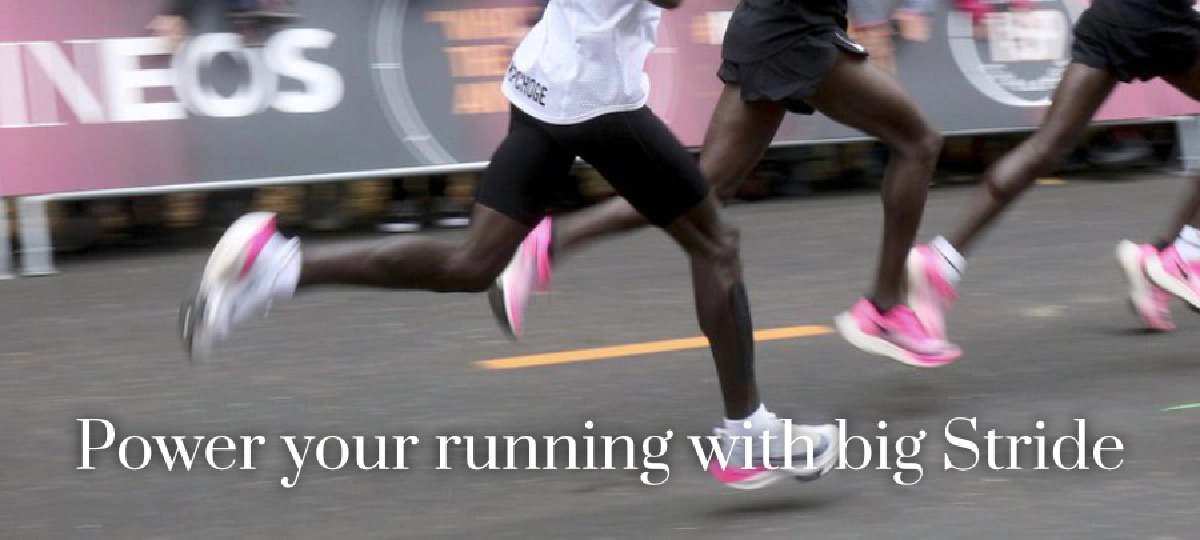
Our earlier post on Cadence covered how cadence is one of the ways to improve running speed. We have seen that cadence is directly proportional to speed.
Running Speed = Stride Length X Cadence
Speed (meters/minute)=Stride Length (meters) x Cadence (strides/minute)
While cadence goes a long way in improving our running speed, there is a natural limit beyond which the performance gains cease. As in the equation above, the other variable that influences running speed is Stride length. Getting an optimal stride is also important for running economy, which is the key to speed endurance (able to maintain speed for longer race distances).
Stride length is defined as the distance between both our feet as we land on the ground successively with the same feet. Step length is half the stride length and is measured between successive feet landing.
In practice, however, most running discussions, GPS watches, and tracking apps use Stride length and Step length interchangeably. For this post, we use stride length synonymous to step length.
This series on running Stride will be covered in 2 parts:
We have analyzed the Strava data of 300 runners who finished the Tata Mumbai marathon 2020(TMM) in under 4hours 30 minutes. Here is a chart of cadence and stride length.
As can be seen, there is a little variation in Cadence (180 to 170) from faster to slower runners, while there is a significant variation in stride length from faster to slower runners. Runners under 3 hours finish time have an average stride length of 130cm, while slower runners finishing beyond 4 hours have stride length less than 100cm.
Even for runs of different distances, cadence remains constant and stride length is highly adaptive for a given runner too. Here is the data from my recent time trials across three different distances, 5k, 10k, and half-marathon.
All the three runs are at level 9 on the scale 1(easiest)-10(hardest) of perceived exertion(RPE) and are my personal bests (21m:37s for 5k, 45m:26s for 10k and 1h:40m:48s for half-marathon). As seen in the charts, average cadence remained constant at 181-182, while the paces varied from 4:18 min/km for 5k to 4:46 min/km for half-marathon). Difference in paces across the distances can be fully attributed to stride length, which varied from 127cm, 122cm, to 116cm. Please see the references at the bottom to see my Garmin logs of these runs.
Stride is primarily powered by the strength and explosiveness of the runner aided by forward lean and gravity. Strength and Power from the bigger muscle groups (Glutes, Hamstrings, and Quadriceps) play an important role. Understanding the mechanics behind the stride is the first step to improving the stride.
The power needed for the running stride majorly comes from the extension of the hip on the side of the stance leg (rear leg on the ground in the picture). As we land with the feet: We flex the three important joints (often referred to as hip flexion, see picture A below), ankle, knee, and hip.
Use of Carbon plates and innovative midsole in shoes (such as PEBA & e-TPU foams) work by improving the energy rebound adding to leg spring stiffness, thereby assisting the stride.
While the stance leg (leg on the ground which is trailing) helps to generate the force to power the stride using hip extension, the leading leg which is swinging forward also plays an equally important role. The leading leg helps the stride by driving the knee forward. The driving force mostly comes as reflex action from the hip extension that happened earlier. Powerful quadriceps and good hip mobility assist the forward motion and optimizes the stride.
Like cadence, stride length is highly individual. There is no ideal stride length to train for. Taller runners normally have bigger strides compared to shorter runners. Elite athletes like Kipchoge, Mo Farah reach stride length of 2 meters. There are multiple components to training for a better stride. These include strength training, mobility work and running drills. The next post in this series will cover the training in detail.

Aravind is a techie, running geek, and a marathoner. He is a CrossFit Level 1 Trainer. He loves all things technology and technology in running, with special interest in running form analysis.
If you are a running enthusiast, follow us on our social media channels @geeksonfeet on Twitter, and GeeksOnFeet on Instagram and Facebook for updates.